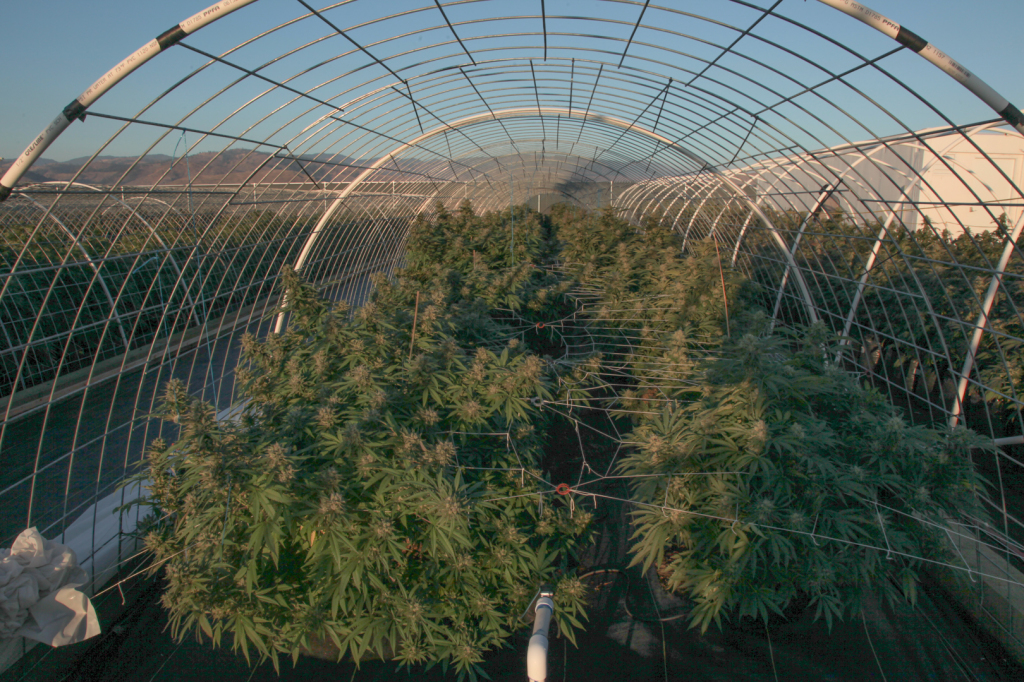Legal Light dep hoops in Omak, Washington, 2014. Photo by Steve Hyde.
by Dominic Corva, Executive Director
It’s spring planting time! What are you going to do with your canopy this year? Hopefully you’re already built out and know how much of your canopy to light dep, how much to go full term, how much to hash crop, and what strains you’ll be focusing on. If not, this post is intended to help outdoor and greenhouse I 502 producers and processors make the most out of their canopy over the next 9 months.
In order to make those decisions, you’ll need to understand how this year’s market dynamics will be very, very different from last year. Last year, just a few dialed-in producers contributed to a fall harvest sizable enough to overwhelm the 60 or so retailers that were open on the first of the year. As a result, prices fell dramatically, approaching par with medical and black market prices at both wholesale and retail. This dynamic panicked many producers, but it gave approved retailers the confidence to open up at a more rapid rate and attracted some unknown number of new consumers to the legal market.
This year, we’ll see the same pattern but on a much, much bigger scale. The variables to watch out for are: how many more retailers will open and how many more effective producers will realize a 1000 lb crop or more?
We still have less than 100 out of 334 allotted retail slots open, with about 125 approved. If conditions hold — conditions that include bans or moratoria in 40% of the WSLCB’s 120 retail jurisdictions — we can expect about double that number open in the fall. That means that if we more than double last year’s 20+ thousand lb fall harvest, we will see prices crash to a level that will put all but the most efficient or capitalized operators out of business. It is possible that the WSLCB will open up retail geographies one way or another, which that would help a great deal.
I project right now that we will have at least five times the 2014 harvest, given that only seven out of 185 producers managed at least 1200 lbs and the next highest volume producer came in around 600 lbs. And all that was on a short-term harvest cycle, with most getting fully vegged plants in the ground from black and gray market sources by early August 2014. This year, you are starting now, more or less; and a whole lot more of you are open. How many more will be the subject of posts this week.
So, excluding the Tier 1s, what do you do with your 21,000 or 7,000 square feet of canopy?
1. Light dep. At least a third of your canopy should be devoted to a light dep harvest, followed by full term canopy once harvested in July at the latest. This way, you’ll be able to get wholesale prices when the market for flower is strongest. Already, we are seeing prices bounce a bit from the winter glut. Inventory is clearing, and more stores are opening, which means we may see a significant wholesale price bump starting in May, through August. The light dep crops will start to drive those prices down in September.
2. Hash crop. If you’re going to see $2/gram wholesale prices in November, save yourself some work and dedicate a huge portion of your field to a hash crop destined for processing rather than flower sales. Hash crops require far less maintenance and minimal grooming at the end, depending on how you intend to process them. You’ll save big on production costs and give yourself the option to either sell high quality raw material (ie, buds as well as trim/shake) to specialist processors, or …
3. Maximize your value-added by processing it under your own license. Whether this means in-sourcing one of the many high quality concentrate specialists from medical and black markets; leasing or purchasing a CO2 or other solvent-based closed-loop system; or, my favorite, using your best material to make high-rated solventless icewax; capturing more value in the process means a great deal for your bottom line.
Currently, 6-star solventless concentrate is the highest value-added cannabis product out there. It’s not easy to make, and the expertise to do so is scarce, so get started now on developing that expertise by identifying or cultivating talent. The first thing you have to know is that it’s all about the raw material, so buds harvested at the maximum terpene level or cured to a maximum terpene profile, are a must. When it comes to hash, it’s not just about potency — it’s about potency and terpenes, which is why BHO concentrates have limited appeal. It’s not impossible to make BHO with a great terpene profile, but it takes a master.
4. Choose your strains wisely. The market potential of legal cannabis is wayyyyyy beyond potency, which is the old reliable for black and gray markets. New consumers are going to want balanced cannabinoid profiles, novel terpene profiles, CBD-rich profiles, and more. For the last several years, domestic cannabis producers have been afraid to commit a significant percentage of their crop to CBD-rich strains. This year, CBD-rich flowers are being sold at a premium and hardly anyone has them in commercial quantities. Don’t be afraid to commit a chunk of your canopy to CBD-rich strains — when everyone else is desperately trying to offload THC-rich material, your CBD-rich material will attract retailers.
Good luck everyone!

data obtained by tetratrac reveals in part that the average paid to farmers is 5 dollars and the average retail price is still near 22
Sage advice Dominic. Hope you are well.